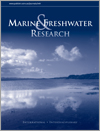Marine and Freshwater Research
Volume 75
Number 17 2024
On the basis of the RUSLE model in LIR basin, key findings indicated varying degrees of soil erosion, with a significant portion experiencing severe erosion. The research also addressed the quantification of errors or uncertainties in remote-sensing data, particularly highlighting differences in delineation accuracy among Landsat 5, 7 and 8. The outcomes are essential for watershed management, offering insights into critical erosion sites and aiding in the development of conservation strategies.
This article belongs to the collection Ecological monitoring and assessment of freshwater ecosystems: new trends and future challenges.
Researchers in Fiji found microplastics in 64% of local edible cockles, with higher levels of microplastics and associated biological stress signs in the edible cockles from more polluted areas. The findings highlighted the need for continuous environmental and biomonitoring of pollution effects in seafood. This scientific contribution will inform and shape future policy on regulating pollution and promoting human-health needs in seafood quality.
The DCG method assesses the risk of seawater mixing with groundwater by evaluating distance from the sea, water movement ease and flow direction in aquifers. Tested in Morocco’s Dradère–Souière plain, it uses a special formula (vulnerability index, Iv) to pinpoint vulnerable coast, offering a practical tool for global coastal regions to protect their precious underground water sources from seawater intrusion.
Deforestation for timber collection and agriculture in the steep mountains of Timor-Leste, where rainfall is often intense, has increased erosion by up to 120 times the natural rate, mainly by landsliding. This has increased the amount of sediment in rivers and on the coast with effects on riverine and marine ecosystems. Reforestation is urgently needed.
Kinship for green sawfish was inferred from single-nucleotide polymorphisms. We identified four pairs of half siblings that were captured at least 500 km apart, including one pair of neonates captured ~860 km and 8 years apart, providing evidence of long-distance movement.





